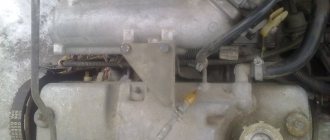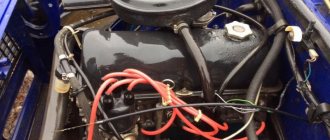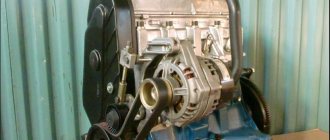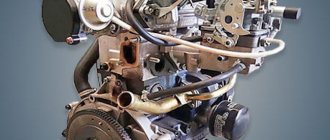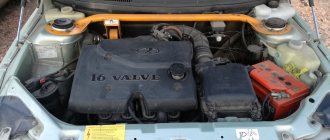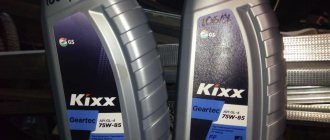Cars of the Chevrolet Niva model received the VAZ-2123 engine, which is quite powerful for this type of car, the main design features of which are a 4-cylinder vertical mechanism. The Chevrolet Niva engine has a built-in fuel injection control system and also complies with European Euro 2 standards for toxic emissions.
Comparing the new modification of the VAZ-2123 with previous analogues, one immediately notices one of the main advantages for the motorist - reduced noise level. This result was achieved thanks to the use of hydraulic chain tensioners, as well as a single-row chain device.
The reason for the reduced noise production is the presence of a hydraulic support for the valves. This engine has one more difference from previous models of this engine - the ability to install knock sensors on the cylinder blocks, which is provided by the bosses.
History of the Niva Chevrolet engine
In 2001, the Niva trademark ended its development. At the same time, the production of domestic SUVs has not disappeared anywhere. The newly created joint venture between GM and AVTOVAZ became the owner of a unique brand of Russian SUV. Further development and production of the Niva began under the name LADA 4x4.
JV AVTOVAZ - GM set themselves the task in a year to create a new model of an SUV that will have the cross-country ability of a Niva and the comfort and build quality of a foreign car. They decided to call the car of joint production Chevrolet-Niva. This model was designed on the basis of already well-proven Niva models with a volume of 1.7 liters. But it was a completely different car, to which numerous changes were made compared to the base VAZ 21214.
The main change in the Niva-Chevrolet is, first of all, a completely new body with a modern shape, a bumper painted to match the color of the car, and permanent four-wheel drive. The transmission, tested by time and life, remains from the previous Niva.
Some mechanisms have undergone major changes:
- The design of the front axle has been changed; it does not have a permanent connection with the engine;
- the intermediate shaft received a more elongated design;
- the design of the gearbox drive has undergone changes;
- the transfer case uses sprockets with finely modular gearing;
- The clutch system on the VAZ 2123 is original;
- The gearbox has undergone significant changes, seals and gaskets, the gearbox mechanism, and main bearings have been replaced;
- both cardan shafts were unified.
The noise from the engine inside the car has become much quieter. This indicates that all the parts and components of the car are tightly fitted, the car was assembled with high Chevrolet quality.
The power plant of the Chevrolet Niva, a modified copy of the VAZ 21214. It retains the valve lifters and on the timing drive, a hydraulic tensioner is installed for a single-row camshaft chain. The camshaft phases were expanded, this innovation made it possible to increase torque at low speeds.
The basic version of the Chevrolet is equipped with a 1.7 liter engine with distributed fuel injection, the power of which is 80 hp. The combustion product exhaust system has a catalytic converter. This allows the VAZ 2123 engine to comply with European emission standards Euro 3 and Euro 2. The VAZ 2123 engine was specially designed and created for the Chevrolet Niva. However, for an SUV with a total loaded weight of 1.8 tons, such an engine turned out to be rather weak. Therefore, Chevrolet will be equipped with gasoline and diesel engines from GM and FIAT, respectively. Back in 2003, an export version was developed, which was equipped with a powerful engine from Opel. This model was mainly exported and was much more expensive.
Model
The new model was first shown at the Moscow Motor Show in 1998, and it was assumed that the series launch would occur in the same year. But the crisis did not allow the manufacturer to start production. As a result, small-scale assembly began only in 2001, and full-scale production began in 2002, having organized a joint venture with General Motors.
Initially it was assumed that this model would replace the regular Niva, but in the end both models began to be produced in parallel. Moreover, Chevrolet Niva occupied the more expensive segment.
Produced all the time at the plant in Togliatti. This is the base site of AvtoVAZ. Most of the components are produced here. Only the Z18XE engine used in the pre-restyling version of the car was imported from abroad. Used only until 2009. This engine was produced at the Szentgotthard engine plant.
Description of the power unit
VAZ 2123 - the power unit installed on the Lada 4x4 is a modified, modified version of the engine of the 21214 model. This is the same four-cylinder gasoline engine, with a vertical arrangement of cylinders and an overhead shaft for distribution of the combustible mixture. The cylinder block is used from the VAZ 21213 model, but it has been modified and modified, so the markings on the engine are original. It is in the block that the main differences between the 2123 engine lie. On the new motor, the attachments are mounted differently, and the adaptation of the unit has significant differences.
The intake tract of the power unit has a different shape, and the engine supports are located differently. On model 21213, the supports are installed cantilever. And on the VAZ 2123 the supports are placed along the central line of gravity. The numbering of cylinders on a Lada 4×4 engine starts from the front of the engine, where the crankshaft pulley is located. Below, on the left side of the cylinder head, the numbering and order in which the cylinders operate is cast - 1, 3, 4, 2.
Power units produced before 2003 had the generator located at the bottom of the engine. On such motors, two belts were used to drive attachments. After 2003, the generator was moved to the left side of the internal combustion engine, to its upper part. These changes made it possible to use one belt to drive all attachments. Belt marking: 5РК1888.
On the BC 2123, the holes for attachments are placed differently than on the BC 21213. To secure the power steering pump, a special bracket was invented. The oil filter is attached through this bracket. On the previous model, the oil filter was screwed directly to the cylinder block.
The crankshaft and a group of pistons were taken from model 21213 and were not modified.
The BC head is used with the VAZ 21214. Its marking is 21214-1003015-30. It has a hole to allow installation of a sensor indicating the position of the camshaft. The design has the ability to install INA hydraulic compensators. The camshaft was borrowed from the 214 internal combustion engine model. The timing drive uses the same single-row chain. To tension the chain, a hydraulic tensioner is used.
The pump on the VAZ 2123 engine has an original design. The roller bearing installed inside the pump of the 2123 engine is more reliable than the ball bearing used on other VAZ models. The pump is usually the weak point. But the 2123 water pump, with roller bearings, fails much less often. The flywheel installed on the 2123 engine has a much larger diameter than the flywheel on the predecessor VAZ 21214.
Which modification is better
It is impossible to say unequivocally which engine is more reliable and better. A lot depends on how you use the car. For urban conditions, the Z18XE is better suited; it is more effective on asphalt. The VAZ-2123 has lower revs, which is very good off-road.
If we take reliability into account, both cars break down. But the Z18XE has much fewer minor faults that ruin the lives of car enthusiasts. At the same time, the VAZ-2123 is well known for minor problems with leaks, sensor failures and other shortcomings.
Source
Technical data of the Niva Chevrolet engine
The manufacturer of the VAZ 2123 1.7 liter power unit is AVTOVAZ. Start of production 2002. This engine is being produced successfully today.
- Four-stroke gasoline engine with an in-line arrangement of four cylinders. The motor has a longitudinal placement in the engine compartment.
- The gas distribution system of the VAZ 2123 is single shaft, having an upper placement of the gas distribution shaft and eight valves, two per individual cylinder.
- The fuel supply system is electronically controlled distributed injection.
- The exact volume of the internal combustion engine is 1690 cubic centimeters. The compression ratio of the VAZ 2124 is 9.3:1.
- Engine power at 5200 rpm min., 81 l., force. Maximum, torque at 4000 rpm min., 127.5 Ni.
- The cylinder diameter of this engine is 82 mm, and the piston stroke is 80 mm.
- The cylinders have an operating order of 1, 3, 4, 2.
- The fuel used is unleaded gasoline AI 95.
- Motor weight 2123 - 127 kilograms.
- The Chevrolet Niva can reach a speed of 140 km per hour. A car can reach a speed of 100 km per hour in 17 seconds, such is the dynamics.
Fuel consumption
Fuel consumption when driving around the city is 14 liters per 100 km, mileage. On the highway 8.8 liters. Total consumption is 8.8 liters per 100 kilometers.
Oil
Types of engine oil: 15W40, 5W30, 5W40, 10W40. The recommended period for replacing engine lubricant is 15 thousand. Allowable oil consumption is 0.70 liters per 1000 kilometers.
Job resource
According to owners' reviews, the service life of the VAZ 2123 engine, with proper operation and maintenance, can reach 250 thousand kilometers.
Engine characteristics
Initially, the Chevrolet Niva was equipped with two engines, depending on the modification - Z18XE and VAZ-2123. After restyling, only the domestic VAZ-2123 engine was left. In the table below you can see the main characteristics of these internal combustion engines.
| characteristic | VAZ-2123 | Z18XE |
| Engine capacity, cc | 1690 | 1796 |
| Maximum torque, N*m (kg*m) at rev. /min. | 127 (13) / 4000 128 (13) / 4000 | 165 (17) / 4600 167 (17) / 3800 170 (17) / 3800 |
| Maximum power, hp | 80 | 122 — 125 |
| Maximum power, hp (kW) at rev. /min. | 80 (59) / 5000 | 122 (90) / 5600 122 (90) / 6000 125 (92) / 3800 125 (92) / 5600 125 (92) / 6000 |
| Fuel used | Gasoline AI-92 | Gasoline AI-92 Gasoline AI-95 |
| Fuel consumption, l/100 km | 10.09.2018 | 7.9 — 10.1 |
| engine's type | In-line, 4-cylinder | In-line, 4-cylinder |
| Cylinder diameter, mm | 82 | 80.5 |
| Number of valves per cylinder | 2 | 4 |
| Add. engine information | distributed fuel injection | distributed fuel injection |
| Piston stroke, mm | 80 | 88.2 |
| Compression ratio | 9.3 | 10.5 |
| Supercharger | No | No |
| CO2 emissions, g/km | 238 | 185 — 211 |
| Engine life thousand km. | 150-200 | 250-300 |
Drivers are often interested in the location of the engine number. Now it is not required to register a car, but in practice it is still sometimes worth checking its compliance. On the Z18XE it is difficult to find it; it is located at the ebb of the engine near the gearbox. Embossed by laser engraving.
On the VAZ-2123 the marking is located between the 3rd and 4th cylinders. It can be counted without any problems if necessary.
Please note that quite often the number is subject to corrosion. Therefore, after purchasing a car second hand, it is recommended to check the quality of the license plate and, if necessary, clean it. To protect the marking, simply lubricate the area with grease or lithol.
Design of BC Niva Chevrolet
The cylinder block 2123 has a special design, which is based on the BC ICE 21213. The new engine has additional equipment. In particular, the power steering mechanism. To install the power steering pump, a bracket is used, which, in turn, serves as an intermediate panel for the oil filter. On the previous block 213 model, the oil filter is screwed directly into the cylinder block. New fastening elements have appeared on the drive cover, this is due to a change in the timing belt tensioning mechanism.
Controller
The controller is a special-purpose mini-computer that consists of random access memory (RAM), programmable read-only memory (PROM) and electrically reprogrammable memory (ERM).
RAM is used by the microprocessor to temporarily store current information about engine operation (measured parameters) and calculated data.
Codes of any faults that occur are also recorded in RAM. This memory is volatile, i.e., if the electrical power is lost (the battery is disconnected or the wiring harness block is disconnected from the controller), its contents are erased.
The PROM stores the engine control program, which contains a sequence of operating commands (algorithms) and calibration data (settings).
The EPROM determines the most important parameters of engine operation: the nature of the change in torque and power, fuel consumption, ignition timing, exhaust gas composition, etc. The EPROM is non-volatile, i.e. the contents of its memory do not change when the power is turned off.
The EEPROM stores controller, engine and vehicle identifiers. Records operational parameters, as well as violations of engine and vehicle operating modes. It is non-volatile memory.
The controller is the central device of the engine control system. It receives information from sensors and controls actuators, ensuring optimal engine performance at a given level of vehicle performance.
The controller is located in the passenger's foot area and is attached to the front panel.
The controller controls actuators such as the fuel injectors, electric throttle body, ignition coil, oxygen sensor heater, canister purge valve and various relays.
The controller controls the switching on and off of the main relay (ignition relay), through which the power supply voltage from the battery is supplied to the system elements (except for the electric fuel pump, electric fan, control unit and APS status indicator).
The controller turns on the main relay when the ignition is turned on.
When the ignition is turned off, the controller delays turning off the main relay for the time necessary to prepare for the next turn on (completion of calculations, setting the throttle valve to the position prior to starting the engine).
When the ignition is turned on, the controller, in addition to performing the functions mentioned above, exchanges information with the APS (if the immobilization function is enabled).
If the exchange determines that access to the vehicle is permitted, the controller continues to perform engine control functions. Otherwise, engine operation is blocked.
The controller also performs a system diagnostic function. It detects the presence of malfunctions in system elements, turns on the alarm and stores codes in its memory that indicate the nature of the malfunction and help the mechanic carry out repairs.
Mass air flow sensor
The engine control system uses a hot-wire mass air flow sensor with a frequency response of a digital output signal.
It is located between the air filter and the intake pipe hose.
The mass air flow sensor signal is a frequency (Hz) signal, the pulse repetition rate of which depends on the amount of air passing through the sensor (increases with increasing air flow).
The diagnostic tool reads the sensor readings as air flow in kilograms per hour.
If a malfunction occurs in the DTV circuit, the controller stores its code in its memory and turns on the alarm. In this case, the controller replaces the sensor readings with a fixed air temperature value (20 °C).
Throttle Position Sensors (TPS)
In a system with an EDP, two TPS are used.
TPS are part of the throttle pipe with electric drive.
The TPS is a potentiometric type resistor, one of the terminals of which is supplied with a reference voltage (5 V) from the controller, and the second is supplied with ground from the controller.
From the pin connected to the moving contact of the potentiometer, the TPS output signal is supplied to the controller.
The controller controls the throttle position electrically in accordance with the position of the accelerator pedal.
Based on the TPS readings, the controller monitors the position of the throttle valve.
When the ignition is turned on, the controller sets the damper to the pre-start position, the degree of opening of which depends on the coolant temperature.
In the pre-start position of the throttle valve, the output signal of TPS 1 should be within 0.65...0.79 volts, the output signal of TPS 2 should be within 4.21...4.35 V.
If you do not start the engine within 15 seconds and do not press the accelerator pedal, the controller de-energizes the electric drive of the throttle pipe and the throttle valve is set to the 7-8% throttle opening position.
In the de-energized state (LIMP HOME) of the electric throttle valve drive, the output signal of TPS 1 is in the range of 0.80-0.85 volts, the output signal of TPS 2 is in the range of 4.15...4.20 V.
Further, if no action is taken within 15 seconds, the check mode (“learning”) of the 0-position throttle valve will begin - complete closing and opening of the throttle valve to the pre-start position, and then the electric throttle valve drive will again switch to de-energized mode.
At any throttle position, the sum of the TPS 1 and TPS 2 signals should be equal to (5±0.1) V.
If a malfunction occurs in the TPS circuits, the controller de-energizes the electric throttle drive, stores its code in its memory and turns on the warning light. In this case, the throttle valve is set to the 7-8% throttle opening position.
Electronic accelerator pedal (EPA)
Vehicles with electronic throttle control use an electronic accelerator pedal that electrically transmits the accelerator pedal position signal to the controller.
The electronic gas pedal is located on a bracket under the driver's right foot.
The electronic gas pedal uses two accelerator pedal position sensors (APPS).
DPPAs are potentiometric type resistors that are powered by a 5V controller.
DPPA are mechanically connected to the drive from the pedal lever.
Two independent springs between the pedal arm and the housing create a return force. Receiving an analog electrical signal from the electronic control unit, the controller generates a signal to control the throttle position.
The output voltage of the DPPA changes in proportion to the pressing of the accelerator pedal.
When the accelerator pedal is released, the DPPA 1 signal should be within 0.46-0.76 V, the DPPA 2 signal should be within 0.23...0.38 V.
With the accelerator pedal fully depressed, the DPPA 1 signal should be within the range of 2.80-3.10 V, the DPPA 2 signal should be within the range of 1.40-1.55 V.
At any accelerator pedal position, the DPPA 1 signal should be twice as large as the DPPA 2 signal.
Coolant temperature sensor (DTOZH)
The sensor is installed in the engine coolant flow, on the outlet pipe of the engine water jacket.
The sensitive element of the coolant temperature sensor is a thermistor, i.e. a resistor whose electrical resistance changes depending on the temperature.
High temperature causes low resistance, and low coolant temperature causes high resistance.
The controller supplies a voltage of 5 V to the coolant temperature sensor circuit.
Knock sensor (DS)
installed on the cylinder block.
The piezoceramic sensing element of the DD generates an alternating current voltage signal, the amplitude and frequency of which correspond to the engine vibration parameters.
When detonation occurs, the amplitude of vibrations of a certain frequency increases. At the same time, the controller adjusts the ignition timing to dampen detonation.
Control oxygen sensor (UDC)
The most effective reduction in the toxicity of exhaust gases from gasoline engines is achieved with a mass ratio of air and fuel in the mixture (14.5-14.6): 1.
This ratio is called stoichiometric. With this composition of the air-fuel mixture, the catalytic converter most effectively reduces the amount of hydrocarbons, carbon monoxide and nitrogen oxides emitted in the exhaust gases.
To optimize the composition of the exhaust gases in order to achieve the greatest efficiency of the converter, closed-loop fuel supply control is used with feedback on the presence of oxygen in the exhaust gases.
The controller calculates the injection pulse duration based on parameters such as air mass flow, crankshaft speed, coolant temperature, etc.
To adjust the calculations of the duration of the injection pulse, information about the presence of oxygen in the exhaust gases, which is provided by the oxygen sensor, is used
The UDC is installed on the exhaust system pipe. Its sensitive element is located in the exhaust gas flow.
The UDC generates a voltage varying in the range of 50-900 mV. This output voltage depends on the presence or absence of oxygen in the exhaust gases and on the temperature of the UDC sensing element.
When the UDC is in a cold state, there is no output signal from the sensor, since in this state its internal electrical resistance is very high - several megohms.
As the sensor warms up, the resistance drops and the ability to generate an output signal becomes possible.
To operate effectively, the UDC must have a temperature of at least 300°C.
For quick warm-up after starting the engine, the UDC is equipped with an internal electric heating element, which is controlled by a controller.
The duty cycle of heater control pulse signals (the ratio of the duration of the on state to the pulse repetition period) depends on the temperature of the UDC and the operating mode of the engine.
If the sensor temperature is above 300° C, then at the moment of passing through the stoichiometry point, the sensor output signal switches between low level (50-200 mV) and high level (700...900 mV).
A low signal level corresponds to a lean mixture (presence of oxygen), a high signal level corresponds to a rich mixture (no oxygen).
Description of the circuit operation
The controller supplies the UDC circuit with a stable reference voltage of 1.6 V. When the UDC is not warmed up, the voltage of the sensor output signal is in the range of 1.2…1.6 V.
As the sensor warms up, its internal resistance decreases and it begins to generate varying voltages outside this range.
By changing the voltage, the controller determines that the UDC has warmed up, and its output signal can be used to control the fuel supply in closed loop mode.
During normal operation of the fuel supply system in closed loop mode, the output voltage of the UDC varies between low and high levels.
Oxygen sensor poisoning
UDC can be poisoned as a result of the use of leaded gasoline or the use during assembly of room temperature vulcanizing sealants containing large quantities of silicone (silicon compounds) with high volatility.
Silicone fumes can enter the crankcase ventilation system and be present during the combustion process. The presence of lead or silicon compounds in exhaust gases can lead to failure of the UDC.
Malfunctions of the UDC circuits, a sensor defect, its poisoning or an unheated state can cause the signal voltage to remain in the range of 1.2…1.6 V for a long time.
In this case, the corresponding fault code will be entered into the controller’s memory. Fuel supply control will be carried out in an open loop.
If the controller receives a voltage signal indicating a prolonged lean state, the corresponding fault code is stored in its memory (low oxygen sensor signal).
The cause of the malfunction may be a short circuit of the UDC output circuit to ground, a leak in the air intake system, or low fuel pressure.
If the controller receives a signal with a voltage indicating a prolonged state of richness of the mixture, the corresponding malfunction code (high signal level of the oxygen sensor) is entered into its memory.
The cause of the malfunction may be a short circuit of the UDC output circuit to the voltage source or increased fuel pressure in the injector rail.
When oxygen sensor fault codes occur, the controller controls the fuel supply in open loop mode.
ShPG design features
The ICE 2123 uses a connecting rod and piston group from the VAZ 21213 engine. The crankshaft guarantees a piston stroke of 80 millimeters. Its marking remained unchanged 21213-1005015. The crankshaft damper pulley, designated 2123-1005058, is designed to work with a poly V-belt. To determine the position of the crankshaft, the pulley is supplemented with a toothed disk. Using the teeth of this disk, a special sensor monitors the position of the crankshaft. The damper is needed to reduce oscillatory vibrations when the crankshaft rotates and reduce the noise of the internal combustion engine. The flywheel of the new internal combustion engine has a large diameter, the working surface of which is 215 millimeters.
Self-diagnosis
If it is not possible to check with a special device, then this can be done using self-diagnosis, which will help to quickly identify all problems associated with the operation of the car. To do this, press the odometer button and turn on the ignition. The speedometer needle will begin to rise to the top; by pressing again, information about the firmware will appear on the screen, and by pressing again, all existing errors will appear.
Let's take a closer look at the Chevrolet Niva error codes with decoding:
During self-diagnosis, error 8 and error 14 often appear, the first informs about problems in the brake system, and the second is related to fuel consumption, quite often this is a system glitch, but in any case you need to replace the sensor responsible for these mechanisms, or reset the memory by resetting the battery terminals.
Timing belt design features
The timing shaft is used from a VAZ 21214. Its drive, along with the oil pump drive, is carried out by a single-row roller chain. Accordingly, all timing drive sprockets installed on the engine are made of single-row sprockets. The oil pump sprocket is smaller, resulting in increased pump performance. Increased MH performance is needed for the correct operation of hydraulic pushers. The spring-hydraulic chain tensioning mechanism is borrowed from the VAZ 21214 engine.
Diagnostics with a scanner
The information in this section is quite extensive, since there are many types of scanners.
The basic principle of their operation is that all data, including errors, is transmitted from the ECU to a special diagnostic connector, which in a Chevrolet Niva is located on the driver's side under the steering wheel.
The scanner's job is to read and decode these messages.
Note that there are dealer scanners, that is, those that are designed for a given car. For Chevrolet Niva this is BC State.
It is inserted into the panel instead of the signaling device, and the information loop is prepared from the factory.
Design features of model 2123 auxiliary mechanisms
The poly V-belt from the crankshaft pulley drives: the power steering pump, generator and water pump. The auxiliary mechanism drive system has support and tension rollers. The pulley is of original design, has the same profile as a poly V-belt. Belt marking 5РК1888, manufactured by the well-known company GATES. The oil pump remains from a VAZ 2121.
The 2123 power unit is equipped with a new pump of an original design. This mechanical part of the engine is subject to constant stress and often fails. Therefore, engineers modernized the water pump. Instead of a conventional ball bearing, a roller bearing was installed on the new pump. The service life of the water pump has increased after this modernization.
Features, diagnostics and replacement of elements of injection systems on VAZ cars
Below we will look at the main controllers!
Hall
There are several options for how you can check the Hall sensor of a VAZ:
- Use a known working device for diagnostics and install it instead of the standard one. If after replacement the problems in engine operation cease, this indicates a malfunction of the regulator.
- Using a tester, diagnose the controller voltage at its terminals. During normal operation of the device, the voltage should be from 0.4 to 11 volts.
The replacement procedure is performed as follows (the process is described using the example of model 2107):
- First, the switchgear is dismantled and its cover is unscrewed.
- Then the slider is dismantled; to do this, you need to pull it up a little.
- Remove the cover and unscrew the bolt that secures the plug.
- You will also need to unscrew the bolts that secure the controller plate. After this, the screws that secure the vacuum corrector are unscrewed.
- Next, the retaining ring is dismantled and the rod is removed along with the corrector itself.
- To disconnect the wires, you will need to move the clamps apart.
- The support plate is pulled out, after which several bolts are unscrewed and the manufacturer dismantles the controller. A new controller is being installed, assembly is carried out in the reverse order (the author of the video is Andrey Gryaznov).
Speeds
The following symptoms may indicate a failure of this regulator:
- at idle, the speed of the power unit floats, if the driver does not press on the gas, this can lead to an arbitrary shutdown of the engine;
- the speedometer needle readings float, the device may not work as a whole;
- fuel consumption has increased;
- the power of the power unit has decreased.
The controller itself is located on the gearbox. To replace it, you only need to jack up the wheel, disconnect the power wires and remove the regulator.
Fuel level
The VAZ or FLS fuel level sensor is used to indicate the remaining volume of gasoline in the fuel tank. Moreover, the fuel level sensor itself is installed in the same housing with the fuel pump. If it malfunctions, the readings on the dashboard may be inaccurate.
Other features of the Chevrolet NIVA internal combustion engine
NIVA2123 has a different motor compartment and a different bridge beam. The gearbox designed for front-wheel drive is not attached to the power unit. Because of this, the sump of the VAZ 2123 engine has a different shape, and the engine mounting supports have a different design than the VAZ 21214 prototype.
The NIVA Chevrolet internal combustion engine has a different air intake system. The air filter size on the new engine has been increased. The dimensions of the intake pipe, receiver and throttle pipe have also been increased.
The motor is controlled by the BOSCH MP7.9.7 ECU or the Russian JANUARY 7.2. On internal combustion engines that comply with Euro 2, a pairwise parallel fuel injection system is used. For internal combustion engines, where Euro 3 requirements must be met, phased fuel injection is used. It provides precise dosage of fuel to a specific cylinder.
The new internal combustion engine has an original fuel rail. It is marked 2123-1144010-11. SIEMENS fuel injectors are used; BOSCH injectors were installed on the first models. The ignition module is used from a VAZ 2112.
Tuning the VAZ-2123 engine
There are several basic ways that, with the help of small changes in the design of the engine, can change its characteristics and increase power.
But you should not expect any high results due to the design features of the mechanism produced by a domestic manufacturer.
Therefore, immediately before attempting to modify the VAZ-2123, it is worth weighing the pros and cons.
Still, there are several ways to slightly optimize the operation of this sample Chevy Niva engine:
You can also completely replace the exhaust system, while increasing the diameter of the exhaust pipes, and replace the catalyst with a flame arrester.
Important! These changes to the engine entail the need to reconfigure the operation of the fuel supply system, since with standard configurations and an increased volume, the fuel supplied to the cylinders will not be enough. That is, you will need to perform chip tuning.
Thanks to the work performed, power increases by 15%, which also leads to an increase in fuel consumption.
Typical faults
Despite serious modernization and numerous improvements, the new engine is subject to many characteristic problems:
Maslozhor
One of the most common and problematic problems is the high consumption of motor lubricant. The longer the engine’s operating life, the greater the consumption of motor lubricant. Repairing the ShPG and replacing valve seals will help fix the problem globally.
Malfunctions of the gas distribution mechanism
The problem may arise with the hydraulic chain tensioner. The weak point is the valve and oil supply tube, made of aluminum. Replacement of these parts may occur at the turn of 50 thousand km. A sign of repair may be a loud noise from the tensioner. If repairs are not carried out in time, the timing chain may slip, which can cause serious mechanical damage.
Engine knocks on this power unit are normal.
The noise comes from the hydraulic compensators. If a knock appears at the bottom of the internal combustion engine, then the reason is the increased clearance of the sliding seals. This is an ironclad sign that a major overhaul of the internal combustion engine will be carried out soon.
Stalls after starting
If the car stalls immediately after starting, the reason is the incorrect operation of the sensor that controls the operation of the throttle valve; the latter must be replaced.
Oil leaks
Frequency motor lubricant leakage occurs from under the oil seal located on the rear side of the crankshaft. There may also be an oil leak from under the valve covers. In this case, you need to replace the gasket.
Why does it troit?
Troubleshooting of the VAZ 2123 occurs when the ignition module does not operate correctly. Less commonly, such a problem can occur due to burnout of one of the valves.
Other troubles
At the turn of 100 thousand km, the mass air flow sensor, IAC, pump or oil pump may fail. It is also possible that the cylinder head gasket burns out or the bracket that secures the intake manifold is destroyed.
The VAZ 2123 power unit has many problems during operation. However, problems happen after a decent mileage. And the low cost, availability of spare parts and the ability to carry out repairs yourself make this engine a reliable and popular domestic engine for the Niva Chevrolet.
Replacement
Even if you take care of the engine and change the oil and filters on time, this does not guarantee the absence of breakdowns. As for purchasing another engine for a Niva Chevrolet, a new one at a dealership costs about 80,000 rubles. Naturally, if you bought a used SUV, such expenses seem excessive.
Regarding used power units, you can find many options in the range of 20,000 – 30,000 rubles. But there are many questions about the condition of such motors.
As you can see, the Niva Chevrolet engine has many weak points. However, there is no alternative to it, and therefore SUV owners have to put up with the situation.
Reliability, weaknesses, maintainability
Reliability
VAZ-2123 is considered a reliable engine. Car owners are satisfied with its technical characteristics and high throttle response.
The main factors characterizing the reliability of any motor are the mileage before major repairs and the safety margin, i.e. the ability to boost the motor.
From Table 1 it can be seen that the unit does not have any problems with these parameters. Car enthusiasts on forums confirm this. For example, forum member V writes: “... I have a Chevy, 350 thousand without cap. repairs, 1.5 liters of oil from replacement to replacement, at 240 the cylinder head was replaced and that’s all…”. His communication colleague P supports: “... the engine (this is subjective) is able to last up to 300 thousand km. (how to ride and how to follow).”
The manufacturer keeps internal combustion engine reliability issues under constant control. Each engine improvement includes developments that increase reliability. So, the pump was replaced, the pan and air intake system were changed, and other improvements were made.
Computer diagnostics
The most complete diagnosis is possible with a computer or laptop. In order to use this method, you must purchase an adapter. This adapter performs two functions at once. It is an adapter from a K-line port to a USB port or to a COM port. It also acts as a decoder, which allows you to transmit signals from the ECU to the PC. You will also need to install the appropriate software on your laptop. There are a lot of free versions on the Internet. There are universal programs, as well as programs written for a specific car. After connecting to the computer, you will need to turn on the ignition and launch the program. The connection will happen automatically.
The interface of the computer program is very convenient and allows even an inexperienced user to navigate intuitively. All functionality can be divided into several sections. These are parameters, errors and settings. If the first two sections are informational, then using the third section you can control the vehicle systems.


